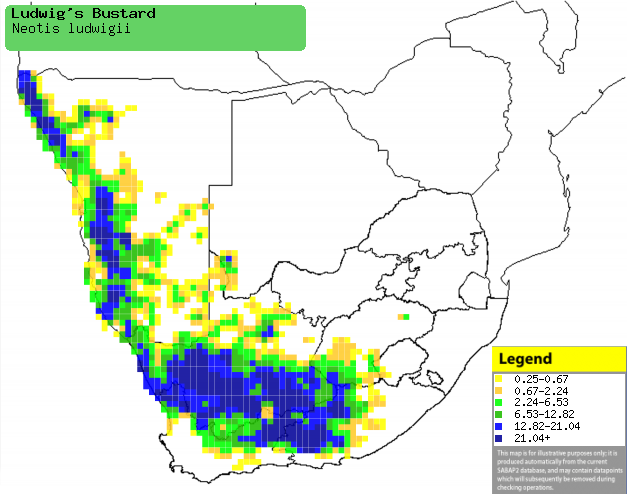|
Neotis ludwigii (Ludwig's
bustard)
Ludwigse pou [Afrikaans]; Iseme (generic term for bustard)
[Xhosa]; iSeme (generic term for bustard) [Zulu]; Khupa (generic term for
bustard) [South Sotho]; Ludwig-trap [Dutch]; Outarde de Ludwig [French];
Ludwigstrappe [German]; Abetarda de Ludwig [Portuguese]
Life
> Eukaryotes >
Opisthokonta
> Metazoa (animals) >
Bilateria >
Deuterostomia > Chordata >
Craniata > Vertebrata (vertebrates) > Gnathostomata (jawed
vertebrates) > Teleostomi (teleost fish) > Osteichthyes (bony fish) > Class:
Sarcopterygii (lobe-finned
fish) > Stegocephalia (terrestrial
vertebrates) > Tetrapoda
(four-legged vertebrates) > Reptiliomorpha > Amniota >
Reptilia (reptiles) >
Romeriida > Diapsida > Archosauromorpha > Archosauria >
Dinosauria
(dinosaurs) > Saurischia > Theropoda (bipedal predatory dinosaurs) >
Coelurosauria > Maniraptora > Aves
(birds) >
Order: Gruiformes
> Family: Otitidae
Distribution and habitat
Near-endemic to southern Africa, occurring from
south-western Angola south through western and southern Namibia to the Northern
Cape and adjacent provinces. It generally prefers the semi-arid shrublands of
the Karoo, Namib Desert and Nama Karoo, occasionally visiting cultivated land
and the southern Kalahari.
|
 |
|
Distribution of Ludwig's bustard in southern Africa,
based on statistical smoothing of the records from first SA Bird Atlas
Project (©
Animal Demography unit, University of
Cape Town; smoothing by Birgit Erni and Francesca Little). Colours range
from dark blue (most common) through to yellow (least common).
See here for the latest distribution
from the SABAP2. |
Predators and parasites
Movements and migrations
Nomad and partial migrant, as it is most common
in the arid Namib Desert and Karoo in winter (May-October), while
mainly occurring in the east of its distribution in summer
(November-April)
Food
Mainly eats arthropods, small vertebrates and plant matter,
doing most of its foraging by walking slowly and pecking the ground in search of
food. The following food items have been recorded
in its diet:
- Animals
- Invertebrates
- Vertebrates
- Plant matter
- seeds
- Homeria miniata (pink tulip) flowers
- berries, seeds and leaves of Lycium oxycladum (Wolwedoring)
Breeding
- Polygynous, with each male defending a small territory from which he
displays to passing females, often mating with several of them in a single
breeding season. Most displaying is done in the early morning and at dusk,
as it needs to forage in the late morning and afternoon.
- The nest is a shallow scrape in the ground, sometimes ringed by pebbles,
typically placed close to the male's display site among concealing
vegetation.
- Egg-laying season is from February-May in Namibia, September-February in
the Nama Karoo and from July-September in the Karoo and Bushmanland.
- It lays 1-3 eggs, which are incubated solely by the female.
- The chicks are cared for by the female only, who sometimes lays flat
with them to avoid detection by predators.
Threats
Vulnerable in South Africa, as it is frequently
killed by man-made traps and collisions with overhead lines.
References
-
Hockey PAR, Dean WRJ and Ryan PG 2005. Roberts
- Birds of southern Africa, VIIth ed. The Trustees of the John Voelcker
Bird Book Fund, Cape Town.
|
